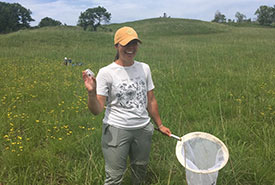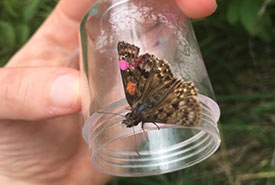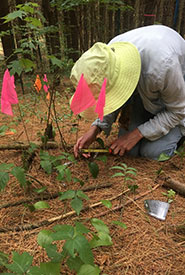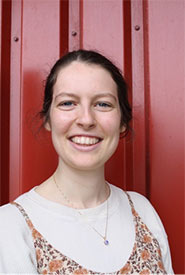A day in the life of a field biologist

Field technician Breanne Kenner with a successful catch! (Photo by NCC)
There are numerous findings in the world of science, and conservation biology specifically, that would not be possible without field work. As part of my conservation internship with the Nature Conservancy of Canada (NCC), I have been given the opportunity to explore the research field work conducted through the Weston Family Conservation Science Fellowship Program.
As a budding conservation biologist, I have field work experience with plants and some other species, but I wanted to see what butterfly field work was all about and learn more about different plant conservation projects. So, on two separate days this summer, instead of my usual workday of literature-based conservation research, I set out to meet up with field teams in the woods of southern Ontario.
Day 1: Butterflies – Northumberland County

A marked mottled duskywing ready to be released. (Photo by NCC)
Following some early morning rain, we gathered our butterfly catching kit and went to work finding mottled duskywings as part of Emily Trendos’ project to fill in knowledge gaps on the endangered species’ habits and population. Although fun, there is a method to butterfly catching that keeps data collection consistent. The study site is divided into consistently sized plots, and the same amount of time is spent searching and catching in each plot.
When a member of the field team spotted a duskywing, a chase ensued! Some running and an excellently timed swish of the net later, a duskywing was caught. The new catch was then chilled in a cooler to make it less active while it awaited its one-of-a-kind paint job. The unique paint markings mean that when this individual is spotted again, whether here or at another study site, it can be determined where the butterfly has already been, when and what it was doing.
Reviewing all the collected data together can inform general species population and movement patterns, helping us understand what the easily hidden duskywing does. If few or no duskywings are found in a plot, then the process is rather quick. If a plot has an abundance of the species, which is usually associated with New Jersey tea, their host plant, the field work starts to feel like a race. When the search clock finally ran out and the last of the butterflies received their personalized paint job, the flags that mark the edge of the plot and the field cooler were packed up, ready for the next plot in the study site.
Day 2: Plants – Norfolk County

Amy Wiedenfeld measuring spotted wintergreen (Photo by NCC)
Field work with plants may be less dynamic than that for butterflies, but the stationary subject allows for much closer observation without a chase-and-cool process.
On a hot sunny day, we set out into the forest in pursuit of a GPS location previously found by others. Beginning first on a trail, often scrambling over large fallen trees left behind from a recent storm, we eventually hit a point where we had to leave the trail and make our own path into the forest.
After some initial struggles to navigate the closed, tight growth of a younger group of trees we were greeted by an open pine forest with plenty of space to walk. Once we arrived at the GPS point we were after, all attention turned to the ground; we were looking for spotted wintergreen, a short (10–25 cm) dark green plant that sends out one to three buds at this point in the season, about mid-July.
After some initial doubt that we would find our study species, we stumbled upon a patch that was being guarded for the purposes of another study, (don’t worry, we had permission to take our measurements). Using a unique identifier, we got to work counting and tagging every plant so that its growth can be tracked over the next few years. After observing the population and taking some soil samples and moisture measurements, we trekked back out of the forest, admiring the many plants along the way.
Reflections
While conducting field work contributes to science, it is also personally rewarding. There are not many other occasions that I can think of, especially not for work, where you are encouraged to observe absolutely everything about the tiny leaf or bug in front of you and the forest around you. For me, there is comfort in knowing that this seemingly random plant in the forest will be visited again, and that someone will be on the lookout for a paint-marked butterfly. I also can’t help but wonder, whenever I stumble upon someone else's study in the form of a banded bird or a tagged tree, what they are trying to find or what interesting places their field work takes them.
These two species are being investigated by Fellows with the Weston Family Conservation Science Fellowship Program, a graduate student training program supported by NCC. Emily Trendos is studying the mottled duskywing as part of her PhD at the University of Guelph and Amy Wiedenfeld is studying three rare plants, including spotted wintergreen, as part of her PhD at the University of Lethbridge. Learn more about the Fellowship projects as part of our interactive story map.


